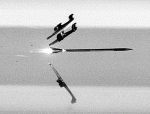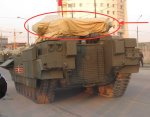I see someone apparently beat me to it, but I am going to post this anyway

The differences between smoothbore and rifled cannons aren’t as predominant as it once was as modern technology has made strides to reduce the gap between the 2. Initially certain munitions were restricted to either kind of gun, but as time has passed various munitions have been made/adapted to work on either kind.
But at the very beginning APFSDS(Armour Piercing Fin Stabilised Discarding Sabot) rounds as well as HEAT (High Explosive Anti Tank) were the main types of rounds that could only be fired by a smooth bore cannon and not by a rifled one. The reasoning behind this was that the rotation put on the round would cause the tungsten/Depleted Uranium penetrator in an APFSDS round to become unstable and wobble as well as lose energy and thus limiting penetration on the target. And in the case of a HEAT round the rotation would destroy the hot molten jet and put a spin on that as well and ultimately also limit that rounds penetration and effectiveness.
But at the same time there were rounds that depended on the rifling to put a spin on the round, for the round to perform effectively and detonate at the right time (based on rotation timer triggers). Rounds such as HESH (High Explosive Squash Head), APERS (Anti PERSonal) and several other rounds.
At the beginning there weren't any other rounds apart from anti tank grade rounds for the smoothbore cannon, but these days several other rounds has emerged and are seeing use by a lot of countries, much like technology has made it possible for rifled guns to fire some types of ammunition previously restricted only to smoothbore cannons. Furthermore rifled cannons tend to wear out a lot faster than smoothbore cannons for obvious reasons. Even the British are planning on putting the rheinmetall smoothbore cannon from the Leopards and the Abrams on their Challenger 2's as a part of their modernisation process as early trials apparently revealed that the German tungsten DM53 round was more effective than the depleted-uranium CHARM 3 round.













































